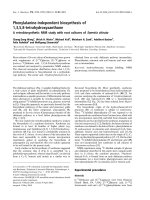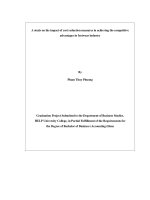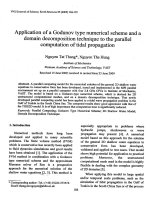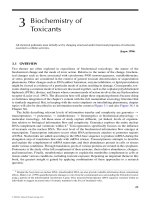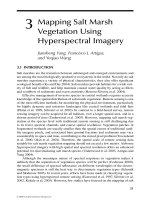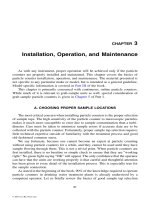Chapter 3 (numerical measures part a) student
Bạn đang xem bản rút gọn của tài liệu. Xem và tải ngay bản đầy đủ của tài liệu tại đây (315.64 KB, 53 trang )
Chapter 3
Statistical
measures
Measure center and
location
Measure
variation/dispersion
Summary
Statistical
measures
Center and
location
- Mean
(arithmetic,
weighted,
geometric)
- Mode, Median
Variation/Disper
sion
- Range
- Variance
- Standard
deviation
1.
2.
3.
4.
5.
6.
7.
Part A
Measures of center and
location
Arithmetic mean
Weighted mean
Geometric mean
Harmonic mean
Median
Mode
Percentile, Quartile
1. Arithmetic mean
The mean of a data set is the average of all
the data values
Arithmetic mean of a data set is defined as
‘ the sum of the values’ divided by the
‘number of values’.
Arithmetic
mean =
The sum of all values
The number of
values
Formula
x1 x2 .... xn
x
n
xi
�
x
n
wher
e
-
are the 1st x-value, 2nd x-value,
x2 , ..., xn
….x
nth
1 ,x-value
- n is the number of data values in the set
Example
If a firm received orders worth:
£151, £155, £160, £90, £270 for five
consecutive months, their average
value of orders per month would be
calculated as:
Limits of arithmetic
mean
2. Weighted mean
Simple
frequency
distribution
Grouped frequency
distribution
Weighted mean of a simple
frequency distribution
xi
f
10
12
13
14
16
2
8
17
5
1
Is the arithmetic
mean appropriate
to a simple
frequency
distribution?
Why?
n
Formula:�xi f i
x
i 1
n
�f
i 1
i
Example
x
f
0
1
2
3
4
5
12
18
30
20
15
5
Tota 100
l
xf
(x): Number of
newspapers/maga
zines/journals a
student read a
week
(f): Number of
students
Weighted mean of a simple
frequency distribution
The mean number of
newspapers/magazines/journals a
student read a week is:
Weighted mean of a
grouped frequency
distribution
Example: The following data relates to
the productivity of workers in a
factory:
Productivi
ty
(items/h)
Number
of
workers
0-9
1019
2029
3039
4049
5059
15
25
30
35
28
17
Weighted mean of a
grouped frequency
distribution
Formula:
n
x
�x
i 1
n
i
�f
i 1
fi
i
Where:
- x: mid-point as representative value
of each class
- f: frequency of each class
Weighted mean of a
grouped frequency
distribution
Productiv Numbe
ity
r of
(items/h) worker
s
0-9
10-19
20-29
30-39
40-49
50-59
15
25
30
35
28
17
xi
xif
Weighted mean of a
grouped frequency
distribution
The average productivity (mean) of
workers in the factory is:
3. Geometric mean
Applicable when the products of data
values are meaningful
Proportional increases and multipliers:
Example:
The number of students attending the
music class last Tuesday was 160. This
Tuesday, the number is expected to
increase by 15%.
How many of them are likely to attend
this Tuesday?
3. Geometric mean
The number of students likely to
attend this Tuesday
Proportional increase?
Proportional multiplier?
Example
To add
(proportional
increases)
Multiply by
(proportional
multipliers)
3. Geometric mean
-
A specialized measure, used to
average proportional increases.
Formula:
Step 1: Express the proportional
increases (p) as proportional
multipliers (1+p)
3. Geometric mean
-
Step 2: Calculate the geometric
mean multiplier
(i) Simple geometric mean multiplier:
applied when each proportional
increase appears once only
gmm n (1 p1 )(1 p2 )...(1 pn )
3. Geometric mean
-
Step 2: Calculate the geometric mean
multiplier
(ii) Weighted geometric mean
multiplier: applied when each
n
proportional
increase repeatedly
fi
appears�
fn
f1
f2
i 1
gmm
(1 p1 ) (1 p2 ) ...(1 pn )
n
fi
fi
�
gmm
�(1 pi )
i 1
3. Geometric mean
-
Step 3: Subtract 1 from the gm
multiplier to obtain the average
proportional increase
average proportional increase = gm
multiplier - 1
Example
The number of bankers of a small
bank over the period 2000-2006 is
presented in the table below:
Year
No of
banke
rs
200 200 200 200 200 200 200
0
1
2
3
4
5
6
200 220 250 262 284 300 312
Example
Year
200 200 200 200 200 200 200
0
1
2
3
4
5
6
No of 200 220 250 262 284 300 312
banke
rs
Propo
rtiona
l
multi
pliers
Example
The average proportional multiplier:
The average proportional increase in
the number of bankers over the period is:

